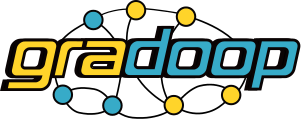-
Notifications
You must be signed in to change notification settings - Fork 88
Data Model
In the extended property graph model (EPGM), a database consists of multiple property graphs which are called logical graphs. These graphs describe application-specific subsets of vertices and edges, i.e. a vertex or an edge can be contained in multiple logical graphs. Additionally, not only vertices and edges but also logical graphs have a type label and can have different properties.
Data Model elements (logical graphs, vertices and edges) have a unique identifier, a single label (e.g. User) and a number of key-value properties (e.g. name = Alice). There is no schema involved, meaning each element can have an arbitrary number of properties even if they have the same label.
This is an example of an EPGM graph collection with two logical graphs. Each logical graph has an id, a single label Community, and a property interest. The vertex with id 3 and label Person is part of both logical graphs.

